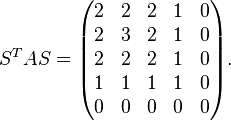Shift matrix
In mathematics, a shift matrix is a binary matrix with ones only on the superdiagonal or subdiagonal, and zeroes elsewhere. A shift matrix U with ones on the superdiagonal is an upper shift matrix. The alternative subdiagonal matrix L is unsurprisingly known as a lower shift matrix. The (i,j):th component of U and L are
where  is the Kronecker delta symbol.
is the Kronecker delta symbol.
For example, the 5×5 shift matrices are
Clearly, the transpose of a lower shift matrix is an upper shift matrix and vice versa.
Premultiplying a matrix A by a lower shift matrix results in the elements of A being shifted downward by one position, with zeroes appearing in the top row. Postmultiplication by a lower shift matrix results in a shift left. Similar operations involving an upper shift matrix result in the opposite shift.
Clearly all shift matrices are nilpotent; an n by n shift matrix S becomes the null matrix when raised to the power of its dimension n.
Properties
Let L and U be the n by n lower and upper shift matrices, respectively. The following properties hold for both U and L. Let us therefore only list the properties for U:
- det(U) = 0
- trace(U) = 0
- rank(U) = n−1
- The characteristic polynomials of U is
- Un = 0. This follows from the previous property by the Cayley–Hamilton theorem.
- The permanent of U is 0.
The following properties show how U and L are related:
- LT = U; UT = L
- The null spaces of U and L are
- The spectrum of U and L is
 . The algebraic multiplicity of 0 is n, and its geometric multiplicity is 1. From the expressions for the null spaces, it follows that (up to a scaling) the only eigenvector for U is
. The algebraic multiplicity of 0 is n, and its geometric multiplicity is 1. From the expressions for the null spaces, it follows that (up to a scaling) the only eigenvector for U is  , and the only eigenvector for L is
, and the only eigenvector for L is  .
.
- For LU and UL we have


- These matrices are both idempotent, symmetric, and have the same rank as U and L
- Ln-aUn-a + LaUa = Un-aLn-a + UaLa = I (the identity matrix), for any integer a between 0 and n inclusive.
Examples
Then 
Clearly there are many possible permutations. For example,  is equal to the matrix A shifted up and left along the main diagonal.
is equal to the matrix A shifted up and left along the main diagonal.
See also
References
Shift Matrix - entry in the Matrix Reference Manual






